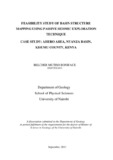| dc.description.abstract | Passive seismic, a non-invasive, cost effective exploration tool, has successfully been used to
provide basin structure information in various geological settings. The analysis of ambient
vibrations, mainly composed of surface waves, provides velocity structure and depth of a
basin. The information obtained through this method can be integrated into analysis of
seismic data acquired using the more conventional seismic methods therefore increasing
efficiency in oil exploration. In some sensitive area e.g. national parks, archaeological sites
and high populated areas, conventional methods may face challenges, therefore a light
weight, low impact method may be required to provide basin information in such areas, of
which passive seismic technique shows great potential for such an alternative.
This method, however, needs to be tested in a wider variety of more complex geology to
assess its reliability in basin architecture mapping. This thesis presents the results of the
analysis of passive seismic data, acquired in Ahero area, Nyanza Basin in Kisumu County,
Kenya.
The data acquisition was carried out by deploying broadband sensors in single (standalone)
stations and in an array configuration in Ahero, Kisumu County in November, 2012 and
allowed to record the natural earth vibrations referred to as ambient noise for at least 48
hours. The recorded data was analysed using two techniques-namely horizontal to vertical
spectral ratio (HVSR) and frequency wavenumber (F-K)-to yield the main resonance
frequency and dispersion curves respectively of the study area. These were then jointly
inverted to obtain a velocity model of the basin from which the structure of the basin was
deduced.
Velocity profiles obtained from this method highlighted three main velocity contrasts at
different depth estimates. The passive seismic results also compared well with results from
active seismic; the first two velocity contrasts were located at similar approximate depths
although the passive seismic method highlighted a third deeper interface which was not well
resolved in the active seismic stacks. | en_US |



